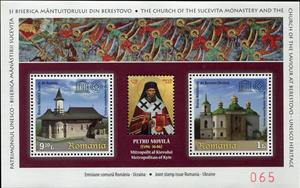Souvenir Sheet: Unesco Churches in Romania & Ukraine SS (Romania 2013)
Unesco Churches in Romania & Ukraine SS (Romania 2013)
21 December (Romania ) within release UNESCO Churches in Romania and Ukraine goes into circulation Souvenir Sheet Unesco Churches in Romania & Ukraine SS face value 9.10+1 Romanian leu
| Souvenir Sheet Unesco Churches in Romania & Ukraine SS in catalogues | |
|---|---|
| Michel: | Mi: RO BL575 |
Souvenir Sheet is horizontal format.
Also in the issue UNESCO Churches in Romania and Ukraine:
- Mini Sheet - Church of The Sucevita Monastery face value 8*9.10;
- Mini Sheet - Church of The Saviour at Berestovo (Ukraine) face value 8*1;
- Souvenir Sheet - Unesco Churches in Romania & Ukraine SS face value 9.10+1;
Souvenir Sheet Unesco Churches in Romania & Ukraine SS it reflects the thematic directions:
A church building, often simply called a church, is a building used for Christian religious activities, particularly worship services. The term in its architectural sense is most often used by Christians to refer to their religious buildings, but it is sometimes used (by analogy) for buildings of other religions. In traditional Christian architecture, the church is often arranged in the shape of a Christian cross. When viewed from plan view the longest part of a cross is represented by the aisle and the junction of the cross is located at the altar area. Towers or domes are often added with the intention of directing the eye of the viewer towards the heavens and inspiring church visitors. Modern church buildings have a variety of architectural styles and layouts; many buildings that were designed for other purposes have now been converted for church use; and, similarly, many original church buildings have been put to other uses. The earliest identified Christian church was a house church founded between 233 and 256. During the 11th through 14th centuries, a wave of building of cathedrals and smaller parish churches occurred across Western Europe. A cathedral is a church, usually Roman Catholic, Anglican, Oriental Orthodox or Eastern Orthodox, housing the seat of a bishop.
A joint issue is the release of stamps or postal stationery by two or more countries to commemorate the same topic, event or person. Joint issues typically have the same first day of issue and their design is often similar or identical, except for the identification of country and value.The United Nations Educational, Scientific and Cultural Organization (UNESCO; pronounced /juːˈnɛskoʊ/) is a specialized agency of the United Nations (UN) with the aim of promoting world peace and security through international cooperation in education, arts, sciences and culture. It has 194 member states and 12 associate members,as well as partners in the non-governmental, intergovernmental and private sector. Headquartered in Paris, France, UNESCO has 53 regional field offices and 199 national commissions



